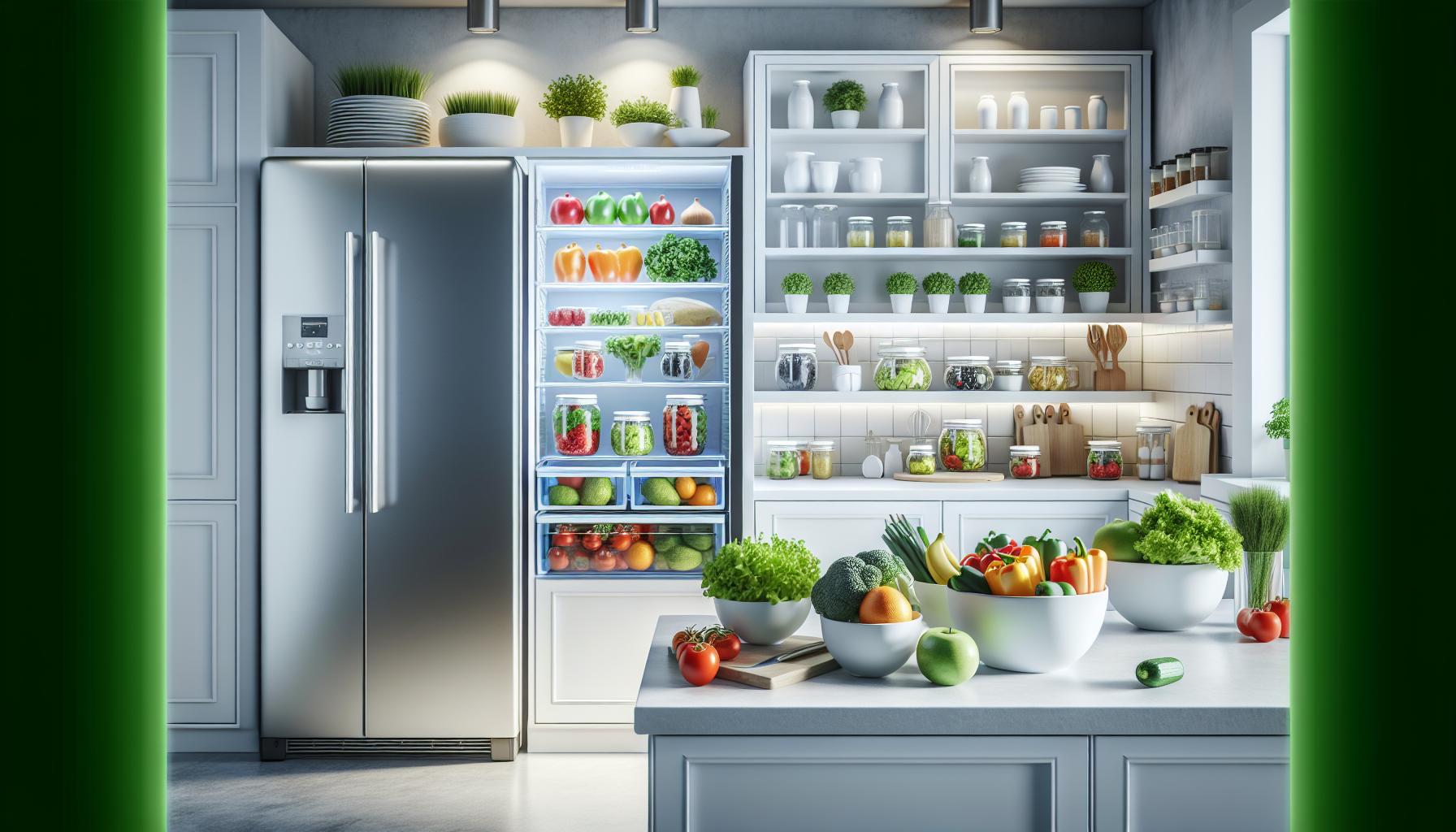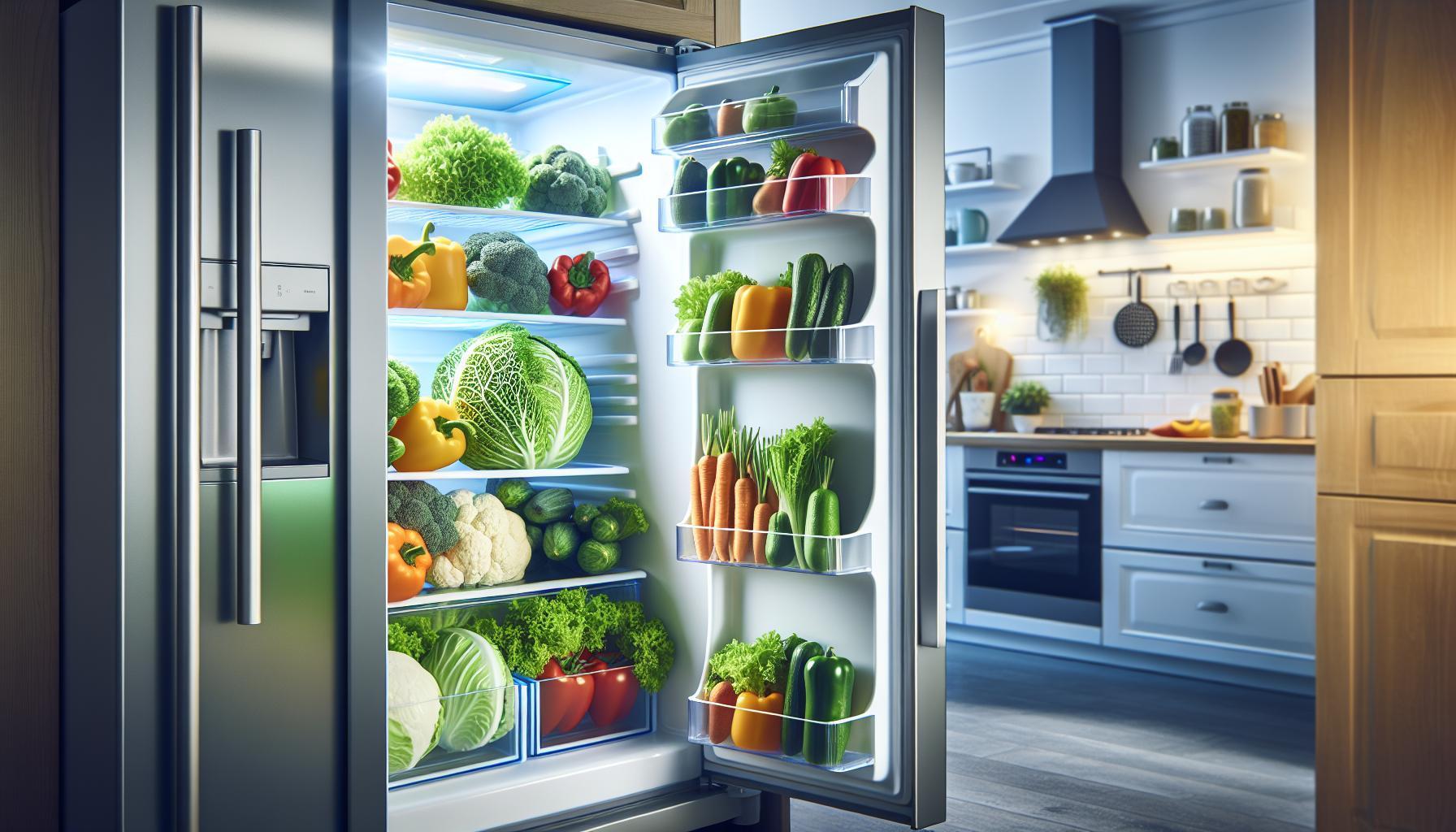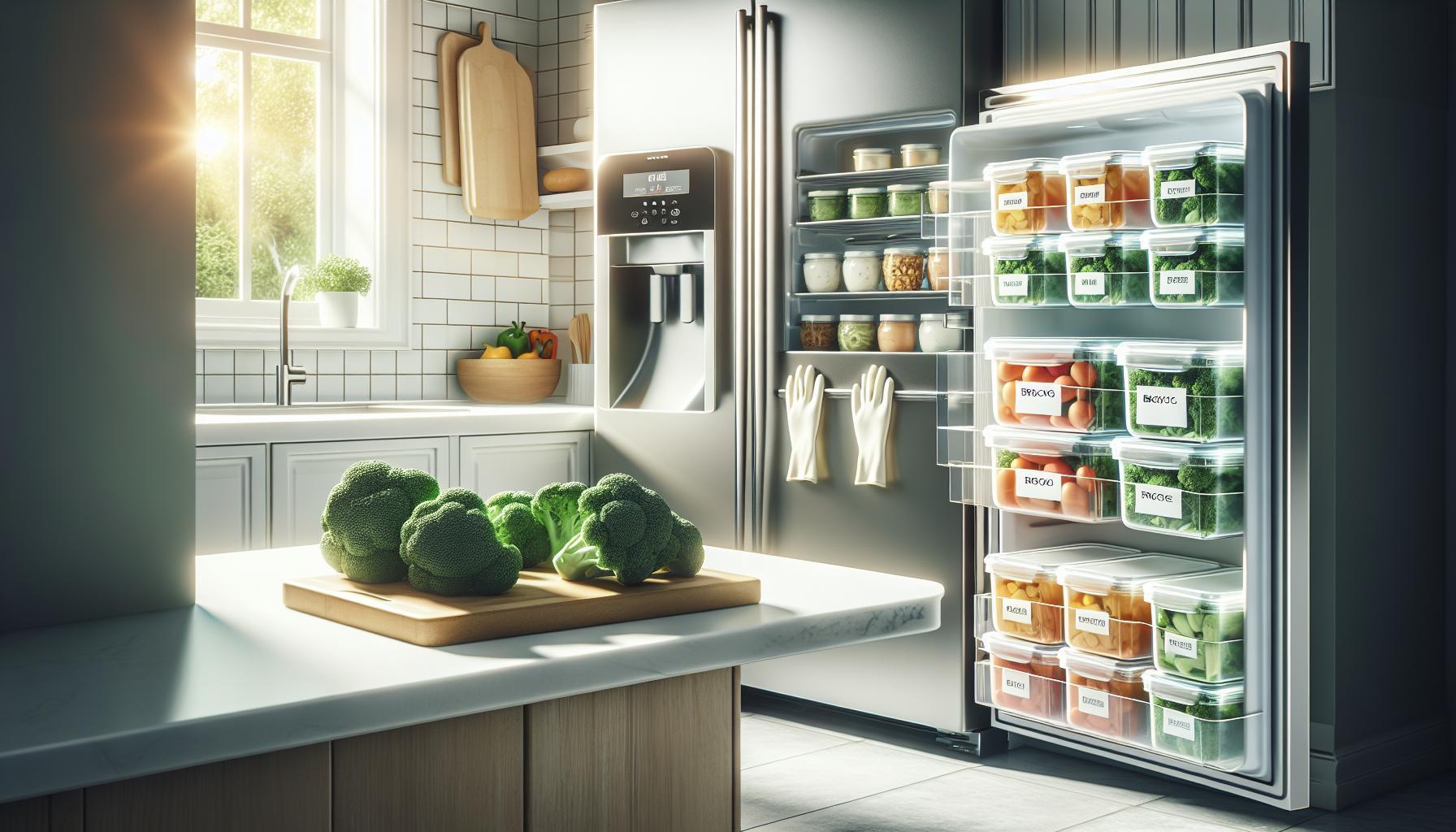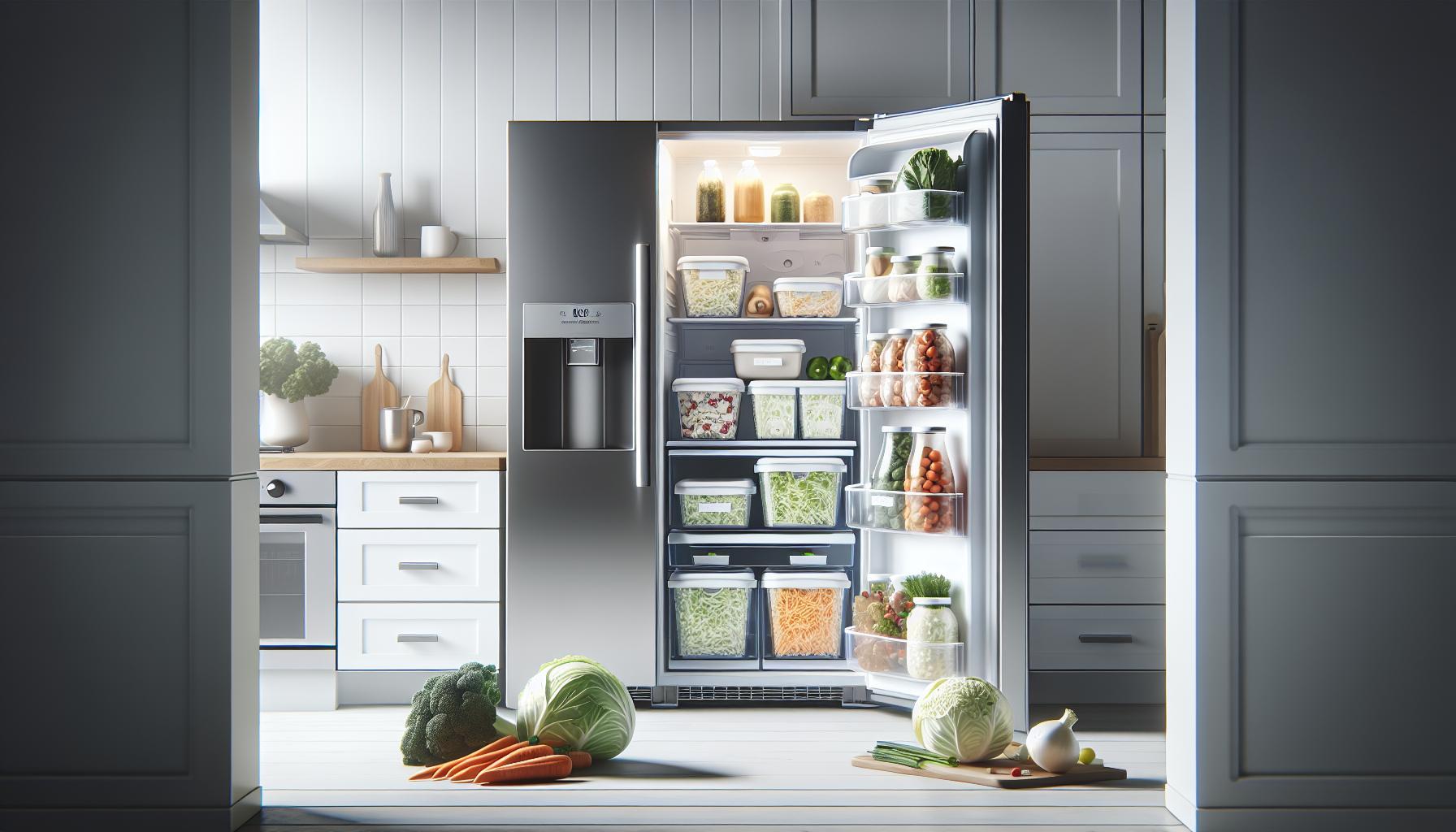Cabbage is not only a versatile and nutritious vegetable but also one that can last quite a while in your fridge if stored properly. Did you know that a single cabbage head can stay fresh for up to two weeks? Understanding how to store this leafy green effectively can help reduce food waste and ensure you’re getting the most out of your produce budget.
As compassionate cooks and health-conscious eaters, we often grapple with the question: how can we maintain the freshness and crunch of our vegetables for as long as possible? Knowing the optimal storage methods and timelines for cabbage not only preserves its delightful texture and flavor but also safeguards its numerous health benefits, making it an essential addition to meals.
In this guide, we’ll explore practical tips and timeframes for cabbage storage, giving you the confidence to keep your fridge stocked with this delightful veggie while minimizing spoilage. Ready to unlock the secrets of cabbage longevity? Let’s dive in!
How Long Does Cabbage Last in the Fridge?
Cabbage is a versatile vegetable that can last surprisingly long in your refrigerator, making it a staple for many kitchens. When stored properly, a whole head of cabbage can remain fresh for about 1 to 2 weeks, while cut or shredded cabbage generally stays good for about 3 to 5 days. This longevity can be attributed to the cabbage’s dense structure, which helps retain moisture and nutrients longer than many other vegetables.
To maximize the freshness of cabbage, it is essential to control the storage conditions in your fridge. The ideal temperature for cabbage is around 32°F to 40°F (0°C to 4°C), which allows it to maintain its crisp texture. Store it in a perforated plastic bag or wrapped in a damp paper towel, which helps to maintain humidity without creating excessive moisture that could lead to spoilage.
Keeping an eye on your cabbage’s appearance can also help you gauge its freshness. Look for any signs of wilting or discoloration. If you notice any leaves that are starting to brown or become slimy, it’s a clear indication that the cabbage is beginning to spoil and should be used promptly or discarded. Proper storage techniques not only help in extending its shelf life but also ensure that you enjoy its delicious crunch in all your favorite recipes.
Ideal Storage Conditions for Maximum Freshness
To maintain the fresh crunch of cabbage, understanding ideal storage conditions is crucial. An optimal refrigerator environment can significantly extend the vegetable’s longevity. Aim to store cabbage at a temperature between 32°F and 40°F (0°C and 4°C). This range is cool enough to inhibit spoilage while still preserving the vegetable’s crispness.
For the best results, place your whole head of cabbage in a perforated plastic bag or wrap it in a damp paper towel. This method retains moisture while preventing excessive humidity from fostering mold or rot. The airflow allowed by the perforated bag or the absorbency of the paper towel helps strike a balance that keeps your cabbage fresh and crunchy.
Additionally, it’s wise to keep cabbage in the crisper drawer of your refrigerator, which is designed to provide the right humidity levels for many fruits and vegetables. Avoid placing cabbage next to ethylene-producing fruits like apples and bananas, as ethylene gas can hasten spoilage. Instead, store your cabbage away from such items to ensure it remains in prime condition for longer. With these storage tips, you can enjoy crisp, delicious cabbage until you’re ready to include it in your next dish.
Best Practices for Preparing Cabbage for Storage
To maximize the freshness and longevity of cabbage, proper preparation for storage is essential. Start by selecting a cabbage that’s firm and heavy for its size, indicating its freshness; avoid heads that feel light or have soft spots. Before storing, cleanse the cabbage under running water to remove any dirt or pesticides. It’s best to leave the outer leaves intact until you’re ready to use the cabbage, as these act as a protective barrier against moisture loss.
When you prepare the cabbage for storage, decide whether to keep it whole or cut it. Whole heads of cabbage last longer than cut pieces due to their natural protective layer. If you choose to cut the cabbage, minimize exposure to air by wrapping it tightly in plastic wrap or storing it in an airtight container. This practice slows down oxidation and helps maintain crispness. For those looking to store shredded cabbage, place it in a sealed container lined with a damp paper towel to regulate moisture.
Utilizing the right storage conditions can also enhance cabbage longevity. Position it in the crisper drawer, which helps control the humidity level. If you’re storing cut or shredded cabbage, aim to consume it within a week, as it tends to deteriorate more quickly than whole heads. Keeping it aware from ethylene-producing fruits and vegetables, like apples and bananas, will further extend its freshness. By following these best practices, you can enjoy crisp cabbage in your meals for as long as possible.
Signs of Spoilage: When to Discard Cabbage
If you’ve ever opened your fridge to find a lonely head of cabbage, you might wonder how to tell if it’s still good to eat. Recognizing the signs of spoilage is crucial for maintaining food safety and ensuring your meals are both delicious and safe. Fresh cabbage should be firm and crisp, but when it begins to spoil, certain telltale signs will reveal its decline.
First and foremost, inspect the leaves for any discoloration. Cabbage leaves that are yellowing, especially if they are wilting or turning a dark brown, are indicators that the cabbage is past its prime. Additionally, feel the cabbage; if it becomes soft or mushy to the touch, it’s time to discard it. A healthy cabbage should retain its firm texture, and any noticeable loss of crispness can signal spoilage.
Other signs of spoilage include:
- Unpleasant Odor: A sour or off-smell is a clear sign that the cabbage has spoiled.
- Mold: If you spot any black or white mold on the leaves, it’s best to toss the cabbage to avoid potential health risks.
- Slime or Excess Moisture: If the cabbage feels slimy or excessively wet, it’s likely decomposing and should not be consumed.
By keeping an eye out for these signs, you can ensure that your cabbage remains a healthy addition to your meals. Always prioritize observing your cabbage visually and texturally; when in doubt, it’s safer to discard it than to risk foodborne illnesses.
How to Extend Cabbage’s Shelf Life Further
To maximize the shelf life of cabbage, proper storage techniques and conditions are essential. Cabbage is highly perishable, but with a few simple strategies, you can keep it fresh for longer. One of the best practices for extending cabbage’s longevity is to store it in an unwashed state. Excess moisture encourages mold growth, so it’s advisable to keep the cabbage dry until you are ready to use it. Wrap the whole head tightly in plastic wrap or place it in a perforated plastic bag to minimize moisture loss while allowing for some airflow.
Another effective method is to store cabbage in the crisper drawer of your refrigerator, which maintains a more consistent humidity level. Ideally, keeping the temperature between 32°F and 40°F (0°C and 4°C) will help prolong its freshness. When storing cut cabbage, ensure it’s wrapped tightly to prevent it from drying out. Using an airtight container can further prevent exposure to oxygen and humidity, factors that could accelerate spoilage.
In addition to these methods, consider using a paper towel inside the wrapping or container to absorb excess moisture. This simple tip can help keep your cabbage crispy and fresh for a longer period. For cooked cabbage, allow it to cool to room temperature before transferring it to an airtight container; it can last up to five days in the fridge when handled properly.
Finally, remember that certain varieties of cabbage, like savoy and Napa, might have slightly different shelf lives due to their moisture content. Regularly check your cabbage for signs of spoilage and adjust your storage approaches based on its specific needs. By implementing these straightforward tips, you can enjoy your cabbage’s delicious crunch and health benefits much longer.
Can You Freeze Cabbage? Pros and Cons
Freezing cabbage can be a fantastic way to preserve its freshness and extend its shelf life significantly. When properly frozen, cabbage can last for up to 10 to 12 months in a freezer, making it a viable option if you’ve bought in bulk or have leftover cabbage from a recipe. However, it’s crucial to understand both the advantages and the drawbacks of this preservation method.
One of the primary benefits of freezing cabbage is that it allows you to maintain its nutritional value, as many vitamins and minerals remain intact even after freezing. This makes it a healthful addition to your diet year-round, enabling you to whip up nutritious meals with ease. To freeze cabbage effectively, start by washing and cutting it into desired sizes. Blanching-briefly boiling the cabbage followed by plunging it into ice water-is essential as it stops enzyme actions that can cause loss of flavor, color, and texture. After blanching for about 2-5 minutes depending on the type, drain and cool the cabbage before placing it in airtight containers or heavy-duty freezer bags, making sure to remove as much air as possible.
However, there are some considerations to keep in mind. Freezing cabbage can alter its texture, often resulting in a softer product once thawed. This makes it less suitable for raw applications like salads but still perfect for cooking, such as in stir-fries, soups, or stews. Furthermore, while freezing prevents spoilage, it doesn’t eliminate all risks; once thawed, cabbage should not be refrozen. Therefore, it’s wise to portion out only what you need for future meals.
In summary, freezing cabbage can be a practical solution to extending its usability while still providing access to its health benefits. Just remember the blenching step and keep in mind that the resulting thawed cabbage is best used in cooked dishes. By freezing with care, you ensure you’re making the most of this versatile vegetable throughout the year.
The Impact of Humidity on Cabbage Longevity
Humidity plays a crucial role in determining the shelf life and quality of cabbage stored in your refrigerator. Notably, cabbage thrives in environments that are neither too dry nor excessively humid. A balanced humidity level helps maintain its crisp texture and prevents premature spoilage, making it vital to understand how to create ideal storage conditions.
Optimal Humidity Levels
Storing cabbage at an humidity level around 90% is considered ideal. This level of moisture helps prevent the leaves from wilting while avoiding the development of mold and bacteria that can occur in overly humid conditions. If your fridge has vegetable crisper drawers, these are specifically designed to maintain higher humidity levels, preserving the freshness of your cabbage longer.
Effects of Excess Humidity
While some moisture is beneficial, too much humidity can lead to a rapid decline in the quality of cabbage. When wet, cabbage leaves can become slimy or develop mold, rendering them inedible. To mitigate this risk, it’s advisable to store cabbage unwashed until you are ready to use it. If you’ve already washed your cabbage, make sure to dry it thoroughly with a paper towel prior to storage. Additionally, wrapping cabbage in a paper towel can help absorb excess moisture while still allowing for some airflow.
Adjusting for Dry Conditions
Conversely, if your refrigerator is too dry, cabbage can dehydrate, resulting in a loss of texture and flavor. To combat dry air, you can place a small container of water in the fridge or store the cabbage in a perforated plastic bag. This method helps to manually regulate humidity levels and creates a more favorable environment for preserving the vegetable’s quality.
By strategically managing the humidity around your cabbage, you can significantly extend its longevity and maintain its nutritional value, ensuring you have fresh, crunchy cabbage ready for your meals.
Common Mistakes That Shorten Cabbage Freshness
Cabbage is a versatile and nutritious vegetable, but common storage mistakes can quickly diminish its freshness and quality, leading to waste. Understanding these pitfalls can help you enjoy crisp, green cabbage longer. One major mistake is storing cut or shredded cabbage in an airtight container. While it may seem convenient, this lack of airflow creates a humid environment, which can foster mold growth and spoilage. Instead, it’s best to store cut cabbage in a loosely wrapped produce bag with a few holes for ventilation, preventing moisture build-up while still protecting it from dehydration.
Another frequent error is washing cabbage before storage. Though it’s important to clean vegetables before consumption, washing cabbage ahead of time adds unnecessary moisture that can speed up decay. It’s advisable to keep cabbage unwashed in the fridge, only rinsing it right before you’re ready to use it. If the cabbage is already washed, ensure it is dried thoroughly with a clean towel and stored with a paper towel to absorb excess moisture.
Not Monitoring Temperature Fluctuations
Many people overlook the impact of temperature changes inside the fridge. Consistent cold temperatures are crucial for extending cabbage longevity. Placing cabbage near the fridge door can expose it to warmer air every time the fridge is opened, leading to premature spoilage. To mitigate this, consider dedicating a space further back in the fridge, where temperatures remain more stable, especially if the rest of your refrigerator tends to fluctuate.
Lastly, not paying attention to ethylene-producing fruits is a common oversight. Foods like apples and bananas emit ethylene gas, which can hasten ripening and spoilage in vegetables, including cabbage. Always store cabbage away from these fruits to keep it fresh longer. Simple awareness of these mistakes can significantly extend the life of your cabbage, ensuring that it remains a crunchy and healthy addition to your meals.
Cabbage Storage: Crisper Drawer vs. Other Zones
The crisper drawer of your refrigerator is specifically designed to maintain optimal humidity levels for fruits and vegetables, making it the ideal spot for storing cabbage. This compartment helps to create a slightly more humid environment, which can prevent the leaves from wilting and drying out. When cabbage is stored in the crisper drawer, it can last up to two weeks or more, provided other storage practices are adhered to. Keeping it wrapped loosely or in a perforated produce bag will enhance airflow and prevent moisture build-up, thus maintaining its freshness longer.
In contrast, placing cabbage in other zones of the fridge, particularly near the door or on shelves that frequently experience temperature fluctuations, can lead to quicker spoilage. The crisper drawer is generally more insulated against these changes, as it remains closed during fridge openings, keeping a steady temperature. Cabbage stored outside the crisper drawer, especially in warmer areas, may only last about a week due to increased exposure to air and light, which accelerates deterioration.
Additionally, the proximity to ethylene-producing fruits can significantly impact cabbage’s longevity. Stores like apples and bananas near the cabbage can cause it to wilt faster, diminishing its crunchy texture. Therefore, if you choose to store cabbage outside the crisper drawer, ensure it’s in a cool, shaded part of the fridge and away from any ethylene-emitting produce. Opting for the crisper drawer not only helps in maintaining the crunchiness of the cabbage but also assists in extending its shelf life, making it a simple yet effective choice for keeping this versatile vegetable fresh for longer.
How to Store Cabbage: Whole, Cut, or Shredded
Storing cabbage correctly can significantly extend its freshness, ensuring you enjoy its crisp texture and nutritional benefits for as long as possible. Understanding the proper methods for storing whole, cut, or shredded cabbage is essential for maintaining its quality. Whole heads of cabbage should ideally be kept intact until you’re ready to use them, as this helps protect the inner leaves from oxidation and moisture loss. Wrap the head loosely in plastic wrap or place it in a perforated produce bag to allow for adequate airflow while retaining some humidity, which keeps the leaves from drying out. When stored this way in the crisper drawer, whole cabbage can last up to two weeks or more.
For cut or shredded cabbage, the storage approach changes slightly due to the increased surface area exposed to air. It’s best to place the cut cabbage in an airtight container or tightly wrap it in plastic wrap to minimize exposure to air and humidity loss. This method helps prevent wilting and the off-flavors that can develop. However, the shelf life for cut cabbage is shorter, typically lasting about five to seven days in the refrigerator. Be sure to check for any moisture accumulation within the container, which can encourage spoilage-if you notice condensation, it’s wise to replace the wrap or transfer the cabbage to a new container.
When freezing cabbage, it’s important to blanch it first. Blanching involves briefly boiling the cabbage before plunging it into ice water, which helps preserve its color, flavor, and texture. Once blanched and cooled, drain the cabbage thoroughly and pack it into freezer-safe bags, removing as much air as possible. Properly frozen cabbage can remain viable for up to a year, making it a great option for later use in soups, casseroles, or stir-fries. However, frozen cabbage will lose some of its crunch, making it less suitable for fresh salads but perfect for cooking.
In summary, knowing the right techniques for storing cabbage-whether whole, cut, or frozen-can help you keep this versatile vegetable fresh and ready for your culinary needs. By following these guidelines, you can enjoy your cabbage for maximum time without sacrificing quality.
Using Leftover Cabbage: Recipes and Ideas
Leftover cabbage presents a fantastic opportunity to create delicious and nutritious meals, proving that this cruciferous vegetable is anything but mundane. With its crunchy texture and versatility, cabbage can be transformed into various dishes that minimize waste and maximize flavor. Whether you have whole leaves or chopped remnants, there are plenty of ways to incorporate leftover cabbage into your meals.
Delicious Ways to Use Leftover Cabbage
- Stir-Fries: Toss shredded or chopped cabbage into a stir-fry with your choice of protein and vegetables. Its slight crunch holds up well during cooking and absorbs savory sauces beautifully.
- Soups and Stews: Add chopped cabbage to soups or stews for an extra boost of nutrients and texture. It works particularly well in hearty dishes like minestrone or potato soup.
- Coleslaw: Revitalize leftover cabbage by making a fresh coleslaw. Mix it with carrots, a tangy dressing, and any other vegetables you have on hand for a crunchy side dish.
- Stuffed Cabbage Rolls: Wrap seasoned meat and rice mixture in whole cabbage leaves, simmer in a flavorful tomato sauce, and create a comforting meal.
- Cabbage Salad: Use thinly sliced cabbage as a base for salads. Combine with fruits, nuts, and a light vinaigrette for a refreshing and crunchy salad.
- Kimchi or Sauerkraut: Ferment leftover cabbage into homemade kimchi or sauerkraut. This not only adds a probiotic-rich food to your diet but also extends the cabbage’s shelf life.
Food Safety and Storage Tips
When utilizing leftover cabbage, be mindful of food safety. Always check for signs of spoilage before use, such as an off smell, discoloration, or slimy texture. If your cabbage has been properly stored in the refrigerator, it should be safe for up to five to seven days after cutting. To maximize its longevity, store it in an airtight container, which helps maintain freshness and prevents wilting.
These creative ideas not only help you use leftover cabbage efficiently but also allow you to explore diverse culinary avenues, enhancing your meals while minimizing food waste. Whether you’re looking to whip up a quick dinner or a side dish, cabbage can adapt to your needs, proving its worthiness as a kitchen staple.
Q&A
Q: How can I tell if cabbage is still good to eat?
A: To determine if cabbage is still good, check for signs of spoilage such as discoloration, slimy texture, or an unpleasant odor. Fresh cabbage should be firm and crisp. If any leaves are wilting, you can remove them, but if the core is soft or foul-smelling, it should be discarded.
Q: Can chopped cabbage last longer in the fridge?
A: No, chopped cabbage typically has a shorter shelf life than whole cabbage. Chopped cabbage can last about 3 to 5 days in the fridge due to increased exposure to air and moisture. For maximum freshness, store it in an airtight container or sealed plastic bag in the crisper drawer.
Q: What is the best way to store cabbage to keep it crunchy?
A: To keep cabbage crunchy, store it in the crisper drawer of your fridge wrapped in a damp paper towel and placed in a perforated plastic bag. This method helps retain moisture without promoting spoilage. Avoid washing the cabbage until you are ready to use it.
Q: How does the humidity level affect cabbage storage?
A: High humidity can be detrimental to cabbage, leading to rot and spoilage. Ideally, store cabbage in a cool, humid environment, like the crisper drawer, but ensure good air circulation to avoid excess moisture. Keeping humidity below 90% helps extend its longevity.
Q: Is it safe to eat cabbage after the expiration date?
A: Eating cabbage past its expiration date is only safe if it shows no signs of spoilage, such as softness, discoloration, or odor. Always conduct a visual and smell test before consumption. If in doubt, it’s better to discard it for food safety.
Q: What are the different types of cabbage, and do they have different shelf lives?
A: Common types of cabbage include green, red, and Savoy cabbage. While they all last about the same time in the fridge (1 to 2 weeks), their firmness and texture can affect how long they remain usable. Savoy tends to spoil quicker due to its more delicate leaves.
Q: Can I store cabbage with other vegetables?
A: It’s best to store cabbage separately from ethylene-producing fruits and vegetables like apples and bananas, as these can accelerate spoilage. Keep cabbage stored with similar vegetables to maintain freshness longer.
Q: How can I use leftover cabbage creatively?
A: Leftover cabbage can be used in various dishes, such as stir-fries, soups, coleslaw, or even braised. Consider making kimchi or adding it to smoothies for extra nutrients. For more recipe ideas, check the “Using Leftover Cabbage: Recipes and Ideas” section of our article.
In Summary
By following these straightforward tips, you can maximize the freshness and longevity of your cabbage in the fridge, ensuring your meals remain delicious and nutritious. Remember, properly stored cabbage can last up to two weeks, making it a versatile ingredient for your salads, stir-fries, and more. However, if you’re unsure about its freshness, trust your instincts-when in doubt, throw it out!
Want to dive deeper into the benefits of cabbage? Check out our articles on the health benefits of cabbage and the different types you can incorporate into your diet. Don’t forget to subscribe to our newsletter for more tips on food storage and healthy eating! Share your favorite cabbage recipes in the comments, and explore our cooking tips section for more insights that will keep your kitchen thriving. Your journey to becoming a cabbage connoisseur starts now!





